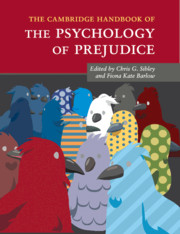Book contents
- Frontmatter
- Dedication
- Contents
- List of Figures
- List of Tables
- Notes on the Contributors
- Part I General Theoretical Perspectives
- Part II Prejudice in Specific Domains
- 11 Understanding the Nature, Measurement, and Utility of Implicit Intergroup Biases
- 12 Aversive Racism and Contemporary Bias
- 13 Ambivalent Sexism in the Twenty-First Century
- 14 Sexism in Intimate Contexts: How Romantic Relationships Help Explain the Origins, Functions, and Consequences of Sexist Attitudes
- 15 Religion and Prejudice
- 16 Sexual Prejudice: Advances in Conceptual and Empirical Models
- 17 Weight Bias: Prejudice and Discrimination toward Overweight and Obese People
- 18 Prejudice Against Immigrants in Multicultural Societies
- 19 Generalized Prejudice: Old Wisdom and New Perspectives
- Part III Prejudice Reduction and Analysis in Applied Contexts
- Index
- References
14 - Sexism in Intimate Contexts: How Romantic Relationships Help Explain the Origins, Functions, and Consequences of Sexist Attitudes
from Part II - Prejudice in Specific Domains
Published online by Cambridge University Press: 17 November 2016
- Frontmatter
- Dedication
- Contents
- List of Figures
- List of Tables
- Notes on the Contributors
- Part I General Theoretical Perspectives
- Part II Prejudice in Specific Domains
- 11 Understanding the Nature, Measurement, and Utility of Implicit Intergroup Biases
- 12 Aversive Racism and Contemporary Bias
- 13 Ambivalent Sexism in the Twenty-First Century
- 14 Sexism in Intimate Contexts: How Romantic Relationships Help Explain the Origins, Functions, and Consequences of Sexist Attitudes
- 15 Religion and Prejudice
- 16 Sexual Prejudice: Advances in Conceptual and Empirical Models
- 17 Weight Bias: Prejudice and Discrimination toward Overweight and Obese People
- 18 Prejudice Against Immigrants in Multicultural Societies
- 19 Generalized Prejudice: Old Wisdom and New Perspectives
- Part III Prejudice Reduction and Analysis in Applied Contexts
- Index
- References
Summary
How can we characterize and understand the relationship between men and women? One answer to this question involves group membership, including the relative social roles men and women “ought to” occupy and thus the extent to which men versus women hold status and power in society. Another involves intimate heterosexual relationships, such as how men and women “ought to” care for each other in their close, personal relationships. These answers highlight the complexities of the relationship between men and women, which can be considered as both intergroup and competitive and interpersonal and cooperative.
As outlined by ambivalent sexism theory (Glick & Fiske, 1996, 2001) these conflicting concerns of power and intimacy produce two related forms of sexist attitudes toward women (see Connor, Glick, & Fiske, Chapter 13, this title). Hostile sexism encompasses competitive attitudes that cast women as incompetent, overly emotional, and attempting to unfairly undermine men's power. These attitudes reinforce men's advantaged societal status by threatening and denigrating women who could challenge men's power. However, protecting societal-level advantages in this manner comes at the expense of men attaining security and satisfaction within intimate heterosexual relationships. Benevolent sexism arises to offset these costs and facilitate men's relationship needs. Benevolent sexism characterizes the relationship between men and women as mutually beneficial and based on complementary traits and social roles: Men are “completed” by cherishing and protecting female partners who, in turn, adopt the role of warm, supportive caregivers.
In their chapter, Connor et al. examined how ambivalent attitudes restrict women's political, economic, and personal power. On the basis of that foundational chapter, here we take a more fine-grained look at the central role that dynamics within romantic relationships play in the emergence, functions, and consequences of hostile and benevolent sexism toward women. Tables 14.1 and 14.2 summarize the principles derived from ambivalent sexism theory and associated research that we review in this chapter. We begin by examining men's endorsement of hostile and benevolent sexism (Table 14.1). We first outline the difficulties that men's hostile sexism creates in romantic relationships and consider how these deficits necessitate benevolent sexism. We then consider the ways men's benevolent sexism functions within intimate relationships to facilitate men's intimacy needs while maintaining and promoting their power. In the second half of the chapter, we turn to women's endorsement of benevolent and hostile sexism (Table 14.2).
- Type
- Chapter
- Information
- The Cambridge Handbook of the Psychology of Prejudice , pp. 321 - 343Publisher: Cambridge University PressPrint publication year: 2016
References
- 11
- Cited by



